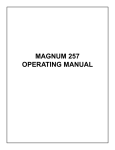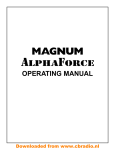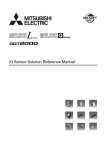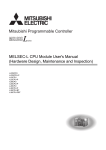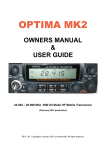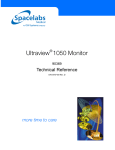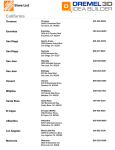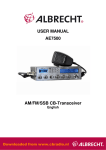Download Magnum 357DX Specifications
Transcript
MAGNUM 357DX OPERATING MANUAL Copyright © 2000 by Magnum International. All rights reserved. TABLE OF CONTENTS Introduction ......................................................................................................... 4 Limited Warranty ................................................................................................. 5 Installation ...................................................................................................... 6 - 7 Front Panel Controls..................................................................................... 8 - 10 Other Features ................................................................................................... 10 Specifications .....................................................................................................11 Contact Information ............................................................................................ 12 -3- INTRODUCTION Congratulations on your purchase of a Magnum 357DX 10 meter FM/SSB/AM transceiver. The 357DX is designed to provide years of enjoyment and trouble-free service. There are many features and functions designed into this transceiver. To ensure that your investment is enjoyed to its fullest extent, please take a few moments and thoroughly read this manual. The Magnum 357DX is a microprocessor controlled, user programmable radio combining both high RF performance with a user-friendly environment. The 357DX is a 12 volt DC, HF transceiver designed for mobile use. The transceiver is configured in two separate components; a high powered RF deck and a compact sized control deck. The two decks are linked via a proprietary control cable. As cabin space diminishes in modern vehicles, this concept helps create a wider variety of installation options. Although engineered with mobile use in mind the 357DX, with the addition of a high quality 50-amp power supply, may be easily adapted for fixed station operation. The control deck utilizes the latest in surface mount production techniques. This keeps the size of the unit to a minimum without sacrificing any of the advanced circuits required for today’s high performance radios. The RF deck incorporates a pair of bi-polar RF transistors in push-pull operation. The devices are continuously biased class A/B using Magnum’s exclusive fully regulated bias circuit. This means unsurpassed audio quality in SSB and AM modes. Some of the features of the 357DX are; an advanced design liquid crystal display that provides the operator with a full visual account of the transceivers operating status, automatic frequency scanning from either the front panel or microphone, memory storage of your favorite frequencies and modes, programmable frequency resolution of either 1 kHz, 10 kHz or 100 kHz, and split frequency operation for repeater use. These are just a few of the features that make the 357DX a pleasure to own and operate. IMPORTANT: The Magnum 357DX is designed for amateur radio use. If the transmitter is operated in the United States or within it’s territories a licensed amateur radio operator must be present at the station. The minimum license class to operate 10 meter phone is Novice/Technician. If you are studying for your license and want to familiarize yourself with the operation of the radio, the receiver may be operated with or without a licensed operator present. For more information regarding FCC licensing, contact your nearest amateur radio dealer, or for complete details contact the American Radio Relay League. American Radio Relay League (ARRL) 225 Main Street Newington, CT 06111 Telephone 860-594-0200 Facsimile 860-594-0259 http://www.arrl.org -4- LIMITED WARRANTY Magnum International warrants this product to be free of defects for a period of one (1) year from the original date of purchase. This warranty is non-transferable. This limited warranty is subject to repair or replacement of defective components only. This warranty is void if the radio has been tampered with or misused. IMPORTANT: RETAIN YOUR SALES RECEIPT The enclosed warranty registration form must be filled out and mailed along with a photocopy of your sales receipt within 15 days from the purchase date. If the warranty registration form and copy of your sales receipt are not received the radio is not covered under warranty. Please fill out the enclosed warranty registration form and send it along with a copy of your sales receipt to: Magnum International PO Box 445 Issaquah, WA 98027 Registering your 357DX with Magnum provides several benefits: 1) Validates your warranty. 2) Entitles you to free updates and information regarding your radio and new accessories for your radio. 3) Provides possible recovery of lost or stolen radios through our serial number tracking database. 4) Receive your free Magnum logo baseball cap within 30 days after registering. -5- External Speaker Jack RF Deck (rear panel) Control Deck (rear panel) Antenna Connector Control Cable D-SUB Jack Control Cable D-SUB Jack Control Cable D-SUB Plug Control Cable D-SUB Jack Power Lead Red (+) Black (-) Control Cable (9 Feet) INSTALLATION 1. Contents Unpack and inspect your Magnum 357DX for missing or damaged components. Your 357DX includes the following items: Quantity 1 1 1 1 1 1 1 1 4. RF Deck Mounting When mounting the RF deck, choose a location that is close to the antenna and the power source. This will maximize RF performance. Make sure that there is ample space around the RF deck for air circulation and for the cabling. Do not pinch, or bend sharply, the control cable, coaxial cable or power cable. Description Magnum 357DX Control Deck Magnum 357DX RF Deck 9 Foot (2.8m) Control Cable Microphone with Up/Down Controls Control Deck Bracket with Hardware RF Deck Bracket with Hardware Microphone Hanger with Hardware Manual, Schematic, Warranty Form The RF deck may be mounted to hang from the bracket (as shown below) or rest on the bracket (as in floor board mountings). The top mounting channel is used to hang the RF deck and the bottom channel is used in floor board mountings. See illustration below. First, attach the mounting bracket to the vehicle with the provided sheet metal screws. Make sure the bracket is extremely secure and stable - the RF deck is heavy! Next, loosely attach all hardware to the bracket. Attach the hardware as shown in the illustration below, with the rubber washer between the square nut and the bracket (rubber washer is not shown in illustration). Slide the RF deck onto the bracket so that the square nuts enter the appropriate mounting channel. The rubber washers should be between the bracket and the RF deck to avoid scratching. Once in position, tighten the screws to secure the RF deck. 2. Microphone Hanger The microphone hanger may be attached to the side of the control deck, or any other convenient location. Use the provided screws to attach the microphone hanger either vertically or horizontally to the side of the transceiver. 3. Control Deck Mounting When attaching the control deck mounting bracket to the vehicle, choose a location that will provide easy access to all front panel controls and air circulation to the rear panel. When selecting a mounting location, make sure that there is ample space behind the control deck for the control cable. Do not pinch, or bend sharply, the control cable. Do not install the control deck in any compartment that restricts airflow and do not install the control deck in a location that interferes with the safe operation of the vehicle. Attach the mounting bracket to the vehicle first then mount the control deck to the bracket. If the rear panel is not accessible you may want to attach the control cable prior to mounting. Top Mounting Channels -6- Bottom Mounting Channels 5. Electrical Connections The Magnum 357DX is designed to work on any 13.8 volt DC, negative ground, source. The condition of a vehicle’s electrical system can affect operation. A low battery, worn generator/alternator, or poor voltage regulator will seriously impair the performance of the transceiver. Any of the above conditions could result in a high level of receiver noise generation or a substantial loss of the transmitter’s RF output. Make sure that all of these components of your vehicle’s electrical system are in good condition prior to installing the transceiver. Once the antenna is mounted on the vehicle, route the coaxial cable so that it is not next to any power cables or vehicle cables. Connect the PL-259 to the antenna connector on the rear panel of the RF deck. Make sure that the cables does not interfere with the safe operation of the vehicle. 7. VSWR After you have determined that the installation is correct and the radio is operational, it is important to determine the antenna system’s VSWR (voltage standing wave ratio). Prior to taking any measurements make sure the SWR bridge (meter) is in good working order and is calibrated.To ensure your radio is performing properly the VSWR should never exceed 1.5 to 1. Never transmit on any antenna system where the VSWR exceeds 1.8 to 1. This will stress the output stage and could destroy the RF transistors; this type of misuse and failure is not covered under warranty. CAUTION! VOLTAGE EXCEEDING 15 VDC WILL DAMAGE THE RADIO. MEASURE VOLTAGE AT BATTERY TERMINALS, WITH VEHICLE RUNNING, PRIOR TO INSTALLATION! Before making any electrical connections make sure the AF gain (volume) control on the control deck is in the “OFF” position. The 357DX power lead is located on the RF deck and must be connected directly to the vehicle’s battery. Connecting directly to the battery has several benefits, the first of which is to maximize RF output. Secondly, the battery is a very large capacitor and will help eliminate certain types of ambient and vehicle noise. Thirdly, the Magnum 357DX draws upwards of 40 amps and most vehicles’ electrical systems can not handle this amount of current. 8. Control Cable Connection The 357DX control deck and RF deck are connected by a proprietary control cable. This control cable is approximately 9 feet long and features two D-SUB connectors with 13W3 pin arrangements. The control cable is non-directional, therefore either end may be attached to the control deck or RF deck. IMPORTANT: The control cable is a tuned cable! Do not under and circumstances attempt to shorten or lengthen the cable. Do not cut the cable, or unsolder any of the wires inside the D-SUB connectors. If a longer or shorter cable is required for your installation, contact Magnum International for more information. For most installations, additional power cable will be required. When running additional power cable, make sure to use 8 gauge, or larger, cable. Available separately from Magnum is a professional vehicle installation kit for your 357DX, model VI-12. The VI-12 kit includes everything (including extra power cable) for a safe and professional vehicle installation. The control cable should only be routed through safe, dry locations that do not interfere with the operation of the vehicle and do not put the control cable at risk of damage. 6. Antenna Connection The transceiver will operate using any standard 50ohm ground-plane, vertical, mobile whip, long wire or similar antenna. The antenna should be rated at 500 watts PEP minimum. A standard SO-239 type antenna connector is located on the rear panel of the RF deck. Connection is made using a PL-259 and high grade coaxial cable (RG213, RG58A/U or Mini RG-8 is recommended). Do not allow the control cable to be bent sharply or routed in a way that may cause damage to the cable. Do not coil excess control cable! Coiling the cable creates an inductive reaction and can create high standing waves under certain operating conditions. Plan your installation carefully to avoid having excess control cable. Do not put force or strain on any part of the control cable or connectors. A ground-plane antenna provides greater coverage and is recommended for fixed station-to-mobile operation. For point-to-point fixed station operation, a directional beam antenna operates at greater distances even under adverse conditions. A non-directional antenna should be used in a mobile installation; a vertical whip is best suited for this purpose. The base loaded whip antenna normally provides effective communications. For greater range and more reliable operation, a full quarter wave whip may be used. After routing the control cable, carefully push the DSUB connectors into the jacks on the rear panels of the control deck and RF deck. When connecting the control cable, take care in lining up the connectors to avoid ‘shorting-out’ any of the pins. Secure the connectors by tightening the screws with your fingers. Be careful not to over-tighten the screws. -7- 16 17 12 13 3 1 2 5 4 14 7 6 15 9 8 10 11 FRONT PANEL CONTROLS 1. MIC: Microphone Input: A 6-pin, lock ring type, microphone connector is used. Microphone wiring is as follows: Pin 1 : Microphone Audio Pin 2 : Receive Pin 3 : Transmit Pin 4 : Down (Up w/ 22K Ohm Resistor) Pin 5 : Ground Pin 6 : +13.8 VDC 4. STEP \ NB \ 1 STEP: Tuning Step. The STEP control selects frequency resolution in either 1 kHz, 10 kHz or 100 kHz steps. Press the STEP button, one of the digits will flash on and off. Press the STEP button again to change stepping resolution. To tune frequencies in either 10 kHz or 100 kHz increments, press the STEP button until the desired digit is flashing. Rotate the FREQUENCY control in either direction. The entire frequency range of the Magnum 357DX can be stepped through in 10 or 100 kHz increments. 2. MIC-G: Microphone Gain: Increases or decreases the energy developed in the microphone amplifier circuit. The gain increases as the control is rotated clockwise. For optimum setting, press the push-to-talk (PTT) switch on the microphone, adjust the mic gain control until all segments of the S/RF display are lit. Next, rotate the control counterclockwise until the last segment of the display starts to flicker. The S/RF display is the bar graph located on the lower edge of the LCD screen. To tune in 1 kHz increments, press the STEP button until the 1 kHz digit flashes on and off. Rotate the FREQUENCY control. NOTE: When stepping in 1 kHz increments, you are limited to tuning within a 10 kHz frequency range. 3. RF-G: RF Gain: Adjusts the receiver sensitivity to both signals and background noise. This affects the distance at which a signal can be detected. Turning the control counterclockwise reduces the receiver sensitivity. This is particularly useful in situations where large volumes of signals are present. The S/RF display indicates the received signal’s strength. The S/RF display is the bar graph located on the lower edge of the LCD screen. NB: Noise Blanker. Noise blanker on and off control. This circuit eliminates pulse type interference usually associated with automotive ignition systems. To activate the noise blanker, press the FUNC control and then press the NB button. NB will appear on the LCD indicating the noise blanker is turned on. To turn off the noise blanker, repeat the same process. 1: Memory Channel 1. After programming this button is memory channel 1. See M.LOAD \ M.SAVE control for programming instructions. IMPORTANT! Operating some of the features in 4 through 9 require the use of the function control. To activate the function control, momentarily push the FUNC (10) control, the FUNC prompt will be displayed in upper left-hand corner of LCD. Push the control again to deactivate the function control. 5. LCR \ RPT \ 4 LCR: Last Channel Recall. Press the LCR button to return to the last frequency that was transmitted on for more than 3 seconds. -8- RPT: Repeater Access Tone. Most repeaters require an 88.5 Hz tone burst to access. To activate the 88.5 Hz tone burst, press the FUNC control and then press the RPT button. RPT will appear on the LCD indicating that the tone burst will now automatically be transmitted whenever the PTT is pressed. To deactivate, repeat the same process. To stop scanning, press the SCAN button, or momentarily press the PTT button on the microphone (scanning will stop without transmitting). 4: Memory Channel 4. After programming this button is memory channel 4. See M.LOAD \ M.SAVE control for programming instructions. To program the offset, press the FUNC button and hold down the SHIFT button for 3 or more seconds. Three digits will appear on the LCD. This is the offset frequency in kHz. Rotate the FREQUENCY control until the desired offset frequency is displayed. To return to the main display press the FUNC button and hold down the SHIFT button for 3 or more seconds, or momentarily press the PTT button on the microphone (the transmitter will not be engaged). SHIFT: Shift Offset. Used for programming offsets to operate repeater networks. The 357DX can transmit and receive on different frequencies. 6. CALL \ 2 CALL: The call frequency is 29.300 MHz, FM. The radio’s operating frequency and mode is automatically reset to this when the CALL button is pressed. 2: Memory Channel 2. After programming this button is memory channel 2. See M.LOAD \ M.SAVE control for programming instructions. To activate the programmed offset frequency, press the FUNC button, and then press the SHIFT button once. +SHIFT is displayed on the LCD. The 357DX will now transmit on the frequency that is XXX kHz greater than the displayed, or receive, frequency (XXX represents the programmed offset frequency in kHz). 7. MODE \ T. LOW \ 5 MODE: Operating Mode. Press the MODE control to select the operating mode. The operating mode is indicated on the liquid crystal display: AM, FM, USB, or LSB. To transmit on the frequency that is XXX kHz lower than the displayed, or receive, frequency press FUNC, then the SHIFT button. Repeat this until -SHIFT is displayed on the LCD. T. LOW: Tone Low. Press the FUNC button, and then press the T. Low button to turn on the receive audio tone control. LOW will appear on the LCD when the low tone is activated. This feature will roll-off high frequency noise (i.e. “white” noise). Under many operating conditions this will improve the clarity and understanding of received signals. To disengage the programmed offset frequency, press the FUNC button and then press the SHIFT button. Repeat this until the SHIFT indicator is no longer displayed on the LCD. 5: Memory Channel 5. After programming this button is memory channel 5. See M.LOAD \ M.SAVE control for programming instructions. 3: Memory Channel 3. After programming this button is memory channel 3. See M.LOAD \ M.SAVE control for programming instructions. 8. SCAN \ SHIFT \ 3 SCAN: Frequency Scan. Scans in increments of 10 kHz. There are two ways to scan using the front panel controls. 9. M.SAVE \ M.LOAD M.SAVE: Memory Save. To save in memory a specific frequency and operating mode, select the desired mode and rotate the FREQUENCY control to the desired frequency. Press the FUNC button, and then press the M.SAVE button. S will appear on the LCD next to the frequency. While S is displayed, immediately press any of the memory channel buttons (1 - 5). The mode and frequency is now saved into memory. If the S indicator disappears before you press the memory channel button, the information will not be saved and the process must be repeated. (1) Receive Audio On Scanning: Press the SCAN button. Scan rate is one step every 5 seconds. To stop scanning press the SCAN button again, or momentarily press the PTT button on the microphone (scanning will stop without transmitting). (2) Receive Audio Mute Scanning: Carefully rotate the squelch control a minimum excursion (refer to 14) until the receive audio is off. Press the SCAN button. The receiver scan rate will now be five frequencies per second. When a signal is detected the squelch is automatically disengaged and the scanning is paused. The squelch circuit will automatically re-engage and the receiver will continue to scan the moment the received signal is no longer detected. M.LOAD: Memory Load (Recall). To load, or recall, any of the saved memory channels press the M.LOAD button. L will appear on the LCD for several seconds. While the letter is displayed press the desired memory channel button (1 - 5). The programmed mode and frequency will be displayed. -9- 10. CLAR \ FUNC CLAR: Clarifier. The clarifier shifts both the TX and RX frequency 1 kHz each side of the center frequency. This is necessary for tuning to an SSB signal. Rotate the clarifier control clockwise or counterclockwise to tune an SSB signal. OTHER FEATURES 1. PROGRAMMING TONE This tone sounds each time the CPU is being programmed. It is helpful, in the beginning so you can be sure the command has been entered. You may turn off the tone by simply pressing the PTT switch on the microphone and turning on the ON/OFF POWER switch at the same time. Repeat this process to turn on the programming tone. FUNC: Function. This control is used to operate the six control buttons on the front panel that are printed in blue. Press slightly and release, FUNC will be displayed on the LCD indicating that the function command is activated. After you have pressed one of the six control buttons the FUNC will disappear from the screen. 2. MEMORY BACK UP The 357DX features a super-capacitor back up for the 5 memory channels. The 357DX can be disconnected from a power source for approximately 4 or 5 days before the memory is lost. 11. FREQ: Frequency. Rotate clockwise or counterclockwise to select the desired frequency. 12. OFF / VOLUME OFF: Turns the power to the radio on and off. VOLUME: Adjusts the AF gain, or volume of the received audio. Turn clockwise to increase and counterclockwise to decrease. 14. SQ: Squelch. Used to eliminate background or “white” noise when monitoring strong signals. Also used to activate SCAN feature (refer to 8). To properly adjust the squelch circuit, rotate the control clockwise until the received white noise is muted. For best results, rotate the squelch the minimum amount necessary to mute the white noise. 15. PWR: Variable RF Output Power. Rotate clockwise to increase RF output power. Rotate counterclockwise to decrease RF output power. Variable RF output power allows low power transmitting for QRP operation in compliance with the FCC request for reduced signal strength during periods when propagation levels are high. 16. Push-To-Talk Switch: Press and hold the switch to transmit. TX will appear on the LCD screen when transmitting. Release the switch to receive. 17. UP / DN: Up and Down Frequency Controls. Press the UP control to increase in frequency. Press the DN control to decrease in frequency. - 10 - GENERAL SPECIFICATIONS Frequency Coverage Antenna Impedance Frequency Control Frequency Accuracy Power Requirement Current Consumption Control Deck Dimensions RF Deck Dimensions Control Cable Dimensions Control Deck Weight RF Deck Weight Control Cable Weight : : : : : : : : : : : : Transmit and Receive ...................................... 28.000 to 29.699 MHz 50 ohm, unbalanced Digital Phase-Lock Loop (PLL) Synthesizer Better than +10 ppm from 0 - 40 0C after 15 min. warm up 12 - 13.8 V DC, negative ground 35 amps maximum 6 x 2 x 8 in (W x H x D) 7.75 x 3.25 x 7 (W x H x D) 9 ft x 0.4 in (L x Ø) 2.4 lbs 4.1 lbs 1.3 lbs TRANSMITTER SPECIFICATIONS Power Output Tuning Steps Final Transistors Spurious Emissions Carrier Suppression Unwanted Sideband FM Deviation Audio Response Frequency Response Microphone Impedance : : : : : : : : : : : : SSB ..................................................................................... 150 Watts FM....................................................................................... 100 Watts AM ............................................... 50 Watts Average / 150 Watts PEP 1 kHz / 10 kHz / 100 kHz SD1446 (x2) More than 50 dB below peak output power More than 40 dB below peak output power More than 50 dB below peak output (1 kHz tone) +/- 2 kHz maximum More than 30dB below peak output 400 to 2800 Hz ECM, 600 to 1K ohms RECEIVER SPECIFICATIONS Circuit Type Intermediate Frequencies Sensitivity Selectivity Clarifier Range Adjacent Channel Rejection IF Rejection Frequency Response Audio Output Power Audio Output Impedance : : : : : : : : : : : : : : Dual-Conversion Superheterodyne 1st IF / SSB IF .................................................................. 10.695 MHz 2nd IF ..................................................................................... 455 kHz SSB ............................................................. 0.25 µV at 10 dB S + N/N AM ................................................................ 1.0 µV at 10 dB S + N/N FM................................................................... 0.3 µV at 12 dB SINAD SSB................................................ 4.2 kHz (-6 dB) / 8.5 kHz (-60 dB) AM / FM .......................................... 6.0 kHz (-6 dB) / 18 kHz (-60 dB) +/- 1 kHz Better than 70 dB Better than 80 dB for all frequencies 250 to 3000 Hz 2 watts minimum at 10% THD with an 8 ohm load 8 ohms - 11 - MAGNUM INTERNATIONAL A Division of RF Limited PO Box 445 • Issaquah WA 98027 Telephone 425-558-9592 • Facsimile 425-558-9704 Technical Support Only 1-877-MAGNUM-9 (1-877-624-6869) http://www.MagnumRadio.com E-Mail [email protected]












